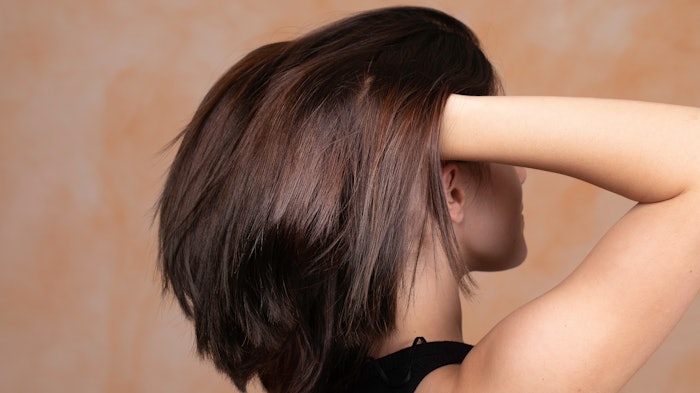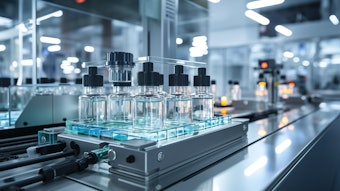
As many readers know, hair is structured much like a cylinder composed of coaxial layers and consists of an outer visible part, the shaft and an internal part rooted in the skin, formed by the bulb and matrix. The shaft comprises three sections with cells containing different types of keratins; these basic proteins form hair as well as the nails and the stratum corneum of the epidermis. Keratin fibers elongate by 0.3 mm per day,1 which amounts to one centimeter per month, multiplied on average by a staggering 100,000 hairs.
Log in to view the full article
Hair Biology Basics
As many readers know, hair is structured much like a cylinder composed of coaxial layers and consists of an outer visible part, the shaft and an internal part rooted in the skin, formed by the bulb and matrix. The shaft comprises three sections with cells containing different types of keratins; these basic proteins form hair as well as the nails and the stratum corneum of the epidermis. Keratin fibers elongate by 0.3 mm per day,1 which amounts to one centimeter per month, multiplied on average by a staggering 100,000 hairs.
All products of sebaceous and sweat secretions converge along the hair shaft and, as sebum ascends, it also absorbs odorous substances and pollutants from the environment. Continuous processes of epithelial cell desquamation occur, sometimes imperceptible to the naked eye and other times manifesting as dandruff.
The matrix and bulb are made up of cells in reproductive activity, multiplying as they move upward, giving rise to the shaft. Surrounding the bulb are capillary blood vessels, from which the cells derive nutrients. Melanocytes are also scattered around, embedded in the hair scaffolding, and are responsible for color.
Hair has a life cycle alternating between phases of activity and reproductive rest. The cycle of each bulb appears to be independent of those surrounding it, and unlike the seasonal molts of animals, humans do not shed their hair all at once under normal conditions.
The well-being of the hair derives not only from a healthy organism, but also from the balance of the scalp, its secretions, blood circulation and resident microflora (bacteria, yeasts and fungi). The properties of the shaft, composed of non-vital cells, depend on both environmental exposure and cosmetic treatments.2
Hair Care Types
Trichological products can be grouped into three main classes: hair cleansers, treatments for hair and scalp anomalies, and aesthetic and styling products. Regarding the first class, today’s formulation research focuses on the use of surfactants with low irritant power – e.g., taurates, sulfosuccinates and isethionates, alongside alkyl polyglucosides, which have recently been rediscovered. The worldwide success of alkyl ether sulfates is on the decline, even if they are still present in many formulas.
The second class includes mainly lotions for the treatment of dandruff, seborrhea and alopecia. These are formulated to ensure the high transdermal absorption of active ingredients.
Finally, the third class encompasses a wide range of combing and styling products. Examples include conditioners, masks, lotions, fixatives and gels.
A different approach to classifying hair products is to divide them by their intended rinse-off or leave-on application. As one might expect, rinse-off formulas would include traditional shampoos and some types of conditioners; leave-on formulas, intended to remain in contact with the hair and scalp for an extended period, could comprise lotions, hair oils, fixatives, etc. The present article delves into the structure and function of basic rinse-off shampoos and conditioners.
Hair and Scalp Cleansing
Today, hair and scalp cleansing products are oriented toward mildness to better maintain cutaneous structures. The ability for a product to visibly improve the mane from the first application, giving it a natural and healthy appearance, is indispensable.
Washing is no longer just about removing dirt; people desire easily combed, soft, shiny hair. Product formulation must consider the continuous stress endured by the hair due to various treatments and environmental conditions (e.g., sun, heat, washing, chlorine in tap water and swimming pools, styling, coloring, etc.) disrupts and alters its keratin, depleting useful lipids and minerals and replacing them with pollutants.
Shampoo properties and sensory effects: An ideal shampoo must move away dirt and sebum without being too aggressive and degreasing to the scalp while respecting the skin’s pH. It must have good foaming properties, possibly with a low surfactant content. The foam must be fine, dense, soft and sufficiently stable, yet easy to rinse off. Indeed, poor, incomplete rinsing is the main cause of scalp irritation, itching and intolerance.3
The hair, once dried, should be soft, voluminous and shiny, and have good dry combability and an antistatic effect. A good shampoo must also scent the environment and deodorize the hair for an extended period.
The combination of all these properties (i.e., sensory, technological and functional) can be achieved through the careful selection of ingredients and appropriate balancing of their properties (see Formula 1, below). The purity of the raw materials used is also essential; metallic impurities and common allergens must be minimized.
Surfactant and ingredient selections: To build a shampoo formula, first, deionized water is typically used to avoid any coloring or pro-oxidant effects due to iron salts and any precipitation due to calcium and magnesium ions in hard water. The main surfactant, generally anionic, acts by carrying out the dissolution or micro-emulsion of surface lipids and environmental dirt deposited on hair and scalp. It should also contribute to the formation of abundant foam during massaging into wet hair.
This is the reason why one of the most widely used primary surfactants is sodium lauryl ether (laureth) sulfate (SLES), with oxyethylene groups interposed between the alkyl chain and sulfate ranging from 1-4 moles or more. The benefits making it a popular choice include good foaming properties, relatively low cost, sufficient skin tolerability, insensitivity to water hardness, easy viscosity with inorganic salts and organic compounds, and hydrolytic stability.
A close relative, sodium lauryl sulfate is usually used in trace amounts despite its strong foaming power and high natural origin index (99%) because of its interaction with ions of hard water as well as greater skin harshness. However, positive neutralizing ions like ammonium, triethanolamine, magnesium or zinc are largely used for reducing the aggressiveness of the alkyl (ether) sulfates, compared to sodium ion.
It is also worthwhile to mention zinc coceth-sulfate, a milder primary surfactant for acid cleansers with additional functionality based on the ability to deposit zinc basic salts during washing onto the skin. This ingredient exerts a deodorizing, antimicrobial and soothing effect.4
Other surfactants with considerable foam development are alpha-olefin sulfonates, alkyl polyglucosides or sodium lauroyl methyl isethionate. This last ingredient is a mild surfactant useful to prepare shampoos characterized by easy distribution, soft foam and easy rinse-off. It can be thickened with PEG derivatives at washing active substance (WAS) concentrations of 1-3%. The best performance is generally obtained in ternary systems containing sodium laureth sulfate and an amphoteric surfactant at the concentration ranges shown in Formula 2 (see below).
Sulfate-free formulas: Sodium cocoyl isethionate can be used as an anionic primary surfactant in sulfate-free shampoos. Combined with disodium cocoamphodiacetate, coco-glucoside, sodium methyl cocoyl taurate or sodium lauroyl sarcosinate, it shows good thickening and foaming properties, characteristics that are usually difficult to achieve without SLES. In fact, in sulfate-free combinations, obtaining the desirable viscosity with low surfactant content is more complex, and modern formulas usually contain a mix of three or four corrective surfactants.
Skin barrier health: A balance among anionic, amphoteric and non-ionic surfactants seems to be the best formulation strategy in terms of maintaining skin barrier health and reducing protein damage and irritation potential. Indeed, some surfactants (i.e., anionics) are harsh toward proteins such as skin keratin, while others are harsh toward lipids (non-ionics and amphoterics).
In practice, the addition of an amphoteric surfactant at about 20–30% with respect to the anionic will reduce charge density, thereby stabilizing the micelles. Since in theory, mixed micelles are less likely to break apart, less surfactant monomers can enter the stratum corneum and damage lipids and proteins.
The amphoteric alkyl amido-propyl betaine has been the most widely used secondary surfactant for years thanks to its low cost, great increase in viscosity in SLES-based cleansers, even if its mildness is limited.
To reduce both protein and lipid damage as well as skin and hair dryness, emollients such as petrolatum, triglyceride oils and C16-C18 fatty acids can be added to formulations.5
Greener ingredients: A green approach includes vegetable-derived surfactants based on amino acids or sugars such as sodium cocoyl glutamate, sodium cocoyl glycinate or olivoyl fructoside, characterized by excellent skin tolerability and mildness or vegetable extracts rich in saponins, terpenic glycosides with surfactant properties, from plants like yucca and Quillaja saponaria. The latter purified extract obtained from this plant acts as a bioactive by improving the imbalance conditions of greasy/oily scalp and acne-prone skin.6
Foam stabilizers: Foam stabilizers are needed to give volume, stability and firmness to a product’s foam. Additional useful effects include increasing viscosity, skin conditioning and hair shine. A shift from the traditional solid monoethanolamides (e.g. cocamide MEA) or long-chain fluid diethanolamides (e.g. cocamide DEA) to alkyl amine oxides with strong hair conditioning effects and plant glycerides with long ethoxyl or polyglycerol chains and some polar esters such as alkyl lactates has taken effect. Myristyl lactate is used as a foam booster and thickener with additional emollient properties, both for SLES-betaine and sulfate-free systems.7
Polyglyceryl-3 caprate is a non-ionic surfactant with a good skin tolerability profile8 and compatibility with most well-known types of surfactants that can make SLES-free products possible. It has foam boosting and refatting properties and is effective in forming an abundant and creamy lather, particularly in association with cocamidopropyl betaine, sodium laureth sulfate and disodium cocoamphodiacetate (see Formula 3, below).
Rheological additives: Rheological additives are added when sufficient viscosity has not been achieved with the mixture between surfactants and foam boosters. The proper viscosity is interpreted by the consumer as a richness and high concentration of ingredients in a formula, but also the suitable distribution of the product from the container to the hand thanks to easy dilution with water and massaging onto the hair – without dripping into the eyes.
The cheapest is sodium chloride, which is already contained as a reaction by-product in the manufacture of many surfactants. It is not advisable to exceed 1.5% of total salt content in cleansers, however, due to possible risks of precipitation at low temperatures and insolubilization of fragrances and active substances over time. Furthermore, the viscosity/salt content curve often has a maximum beyond which values collapse.9
PEG-150 distearate has been used extensively as a thickener, despite the need of preparing a pre-solution of it before adding it to the formula. One main advantage is the high transparency and brilliance it gives to the cleanser, even if it does not enhance foam.
A note on hydrophilic polymers: Hydrophilic polymers that are swellable in water are rarely used because they can interfere with manufacturing time and they often compete with surfactants for water coordination. Some of them, e.g., xanthan gum, are used to suspend insoluble particles or optical additives such as opacifiers (acrylic or acryloyl-styrene polymers) or pearlizers (surfactant mixtures with crystallized stearic acid derivatives); optical additives also include all soluble dyes.
Packaging, fragrance and additional properties: Often packaged in transparent containers, shampoos must be light-stable, a task charged to UV filters added either in the formula or in the plastic material.
Perfumes also play a key role in the success of commercial products. The scent notes released by warm water in the shower send a sensory message of pleasantness and enchantment to the user. Generally, shampoo fragrances do not require solubilizers because the surfactants are able to micro-emulsify them in the formula. However, to improve solubilization or ease of addition during the production process, they can be pre-mixed with foam boosters. Mixtures of odorants must be prepared in consideration of the hydrolytic effect of the surfactant system. Often, their introduction causes significant changes in the rheology of the system by decreasing the viscosity.
Lastly, one or more conditioning ingredients may be incorporated into today’s cleansers. These act by depositing on the hair, forming protective and shiny films capable of repairing the surface of keratin structures (see Formula 4, below).
Conditioner Ingredients and Formulas
Conditioning ingredients, mainly quaternary ammonium salts, act by substantivity (i.e., surface fixation) of the positive electrical charges to negatively charged hair keratin sites. This neutralizes and deposits them along the hair shaft, lubricating and smoothing the hair surface. The result is an improvement in shine, softness and strength, in conjunction with a reduction of brittleness and porosity. The interaction of these materials with hair structures is facilitated by acidic pH values (4-5), allowing for great adhesion of the hair cuticle scales.
Balancing effects: The types and relative amounts of cationic polymers should be calibrated to give a good immediate result while avoiding excessive build-up on the hair following repeated treatments, which can make hair heavy and oily. Conditioning ingredients are mainly cationic molecules that are compatible with the surfactant system. They can be monomeric quaternary ammonium salts (e.g., cetrimonium chloride); synthetic polymers (e.g.., polyquaternium-7, 39, 44); cationic derivatives of guar or cassia gums; or quaternized protein derivatives (e.g., keratin, silk, amino acids), which generally lower the harshness of surfactants to skin (see Formula 5, below).
Conditioner structure and function: The typical conditioner formulation is an o/w emulsion with high water content, structured by the swelling of emulsified cetyl/cetylstearyl/behenyl alcohols. In this category of products, functional additives certainly have more time to act than in shampoos because conditioners should hold onto the scalp for at least one minute before rinsing.
Hair lubrication and shine: Emollients provide hair lubrication, shine and combability. They range from saturated branched hydrocarbons, such as polydecenes and polyisobutenes, to branched-chain esters with high refractive index, such as isostearyl derivatives. Silicones are one of the most common film-forming agents used in conditioners. They are very hydrophobic and capable of waterproofing the hair shaft, protecting it from environmental damage. There are various types of silicones that show different deposition, adherence and rinse-out capacities, resulting in conditioners with distinct performances.
Following the halt in use of cyclopentasiloxane due to its bioaccumulation, dimethicone of various molecular weights has become one of the most-used within the silicone family. It contributes to restoring the hydrophobicity of the hair and acts as a lubricant. To promote the deposition of dimethicone on anionic fibers, additional cationic bridging agents are added to the formulation to increase the affinity between charged hair and silicone. Or, an alternative approach is to use cationically modified high molecular weight polymers, combining the film-forming action with the enhanced cationic interaction.10
Hair repair: Among the restoring agents, humectants promote water retention, a useful mechanism for reducing hair brittleness. Traditional polyols (glycerin, di-glycerin) are widely used, although osmotic protectants (betaine, trehalose) are gaining increasing success. Isopentyldiol, for example, is a multifunctional molecule with reparative effects on damaged hair. It improves resistance to breakage, hair shine and softness. Moreover, it enhances dye retention by protecting hair from color fading and exerts an anti-frizz action (see Formula 6, below).11
Conclusion
Hair is a visible element of individual well-being, social communication and a prime field in cosmetics, dealing with a complex physiological system, characterized by significant sensory and aesthetic requirements for today’s market. Formulating trends indicate the use of alkyl ether sulfates is in decline and the focus is heavily on using greener surfactants with lower irritant power.
Furthermore, cleansing performance, foaming power and foam quality are perceived by modern consumers as being less relevant than in the past compared with dermal compatibility, hair and scalp protection, repair and conditioning, along with naturality and environmental aspects, according to the authors’ experiences. Yet as consumer desire continues to evolve and customizable formulations garner more interest and accessibility, modern hair care will find greater prominence in this industry that continues to strive for innovation.
References
1. Vingler, P., et al. (2007, Apr). 6-O Glucose linoleate supports in vitro human hair growth and lipid synthesis. Int. J. Cosmetic Sci. Available at https://pubmed.ncbi.nlm.nih.gov/18489329/
2. Kalabusheva, E.P., Chermnykh, E.S., Terskikh V.V. and Vorotelyak, E.A. (2017, May 3). Hair follicle reconstruction and stem cells, hair and scalp disorders. InTech. Available at https://www.intechopen.com/chapters/53304
3. Vogeli, D. (2008, Jan). The effect of washing and drying practices on skin barrier function. J Wound Ostomy Continence Nurs. DOI: 10.1097/01.WON.0000308623.68582.d7
4. Rigano, L., Merlo, E., Guala, F. and Villa, G. (2009, Feb 16). Stabilized solutions of zinc coceth sulfate for skin cleansing and skin care. Cosmetics & Toiletries. Available at https://www.cosmeticsandtoiletries.com/cosmetic-ingredients/cleansing/article/21833673
5. Ananthapadmanabhan, K.P., et al. (2009). A novel technology in mild and moisturizing cleansing liquids. Cosmetic Dermatology, 22(6) 307-316.
6. Rigano, L., Bonfigli, A. and Walther, R. (2012). Bioactivity evaluations of Quillaja saponaria (soap bark tree) saponins in skin and scalp sebaceous imbalances. SOFW, 138, 3-2012, 14-21.
7. Zetemol, A.L. (2014, April). Special natural thickener. H&PC Today, 9(2) 52-53.
8. Fiume, M.M., et al. (2023). Safety assessment of polyglyceryl fatty acid esters as used in cosmetics. Int. J. Toxicol., 42, 2 suppl, pp. 5S-101S.
9. Staszak, K., Wieczorek, D. and Michocka, K. (2015). Effect of sodium chloride on the surface and wetting properties of aqueous solutions of cocamidopropyl betaine. J Surfactants Deterg. 18(2) 321-328.
10. Fernandes, C., Medronho, B., Alves, L. and Rasteiro, M.G. (2023, Jan 24). On hair care physicochemistry: From structure and degradation to novel biobased conditioning agents. Polymers (Basel). 5(3) 608.
11. Rigano, L. and Deola, M. (2018, Jun). Hair trio triumph - isopentyldiol for color care, strength and anti-frizz. Cosmetics & Toiletries. Available at https://www.cosmeticsandtoiletries.com/formulas-products/hair-care/article/21837154/hair-trio-triumph-isopentyldiol-for-color-care-strength-and-antifrizz










